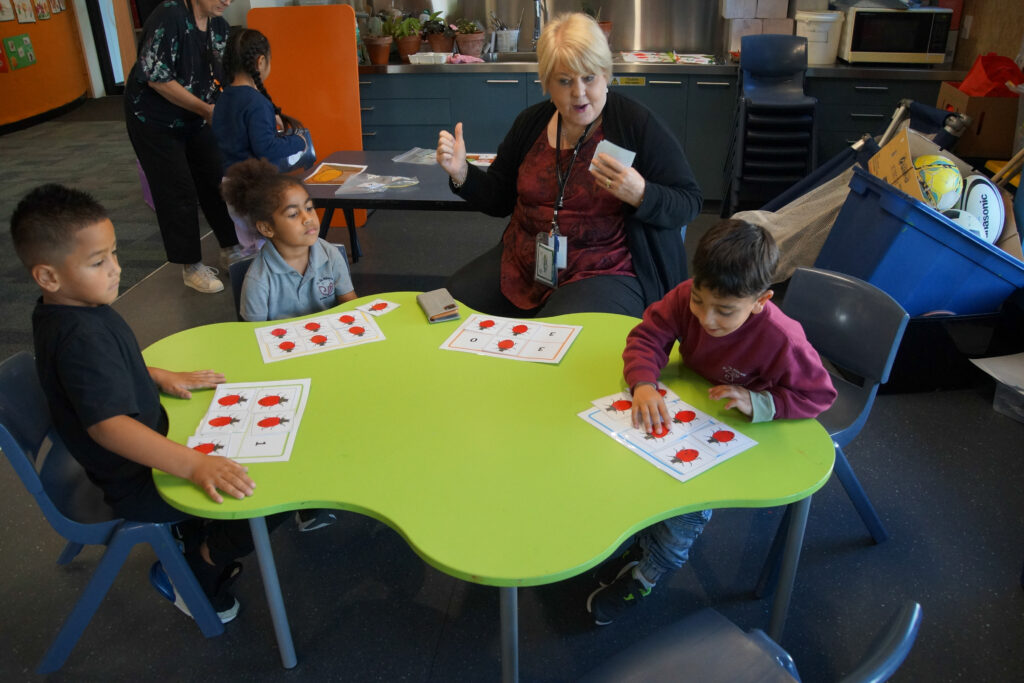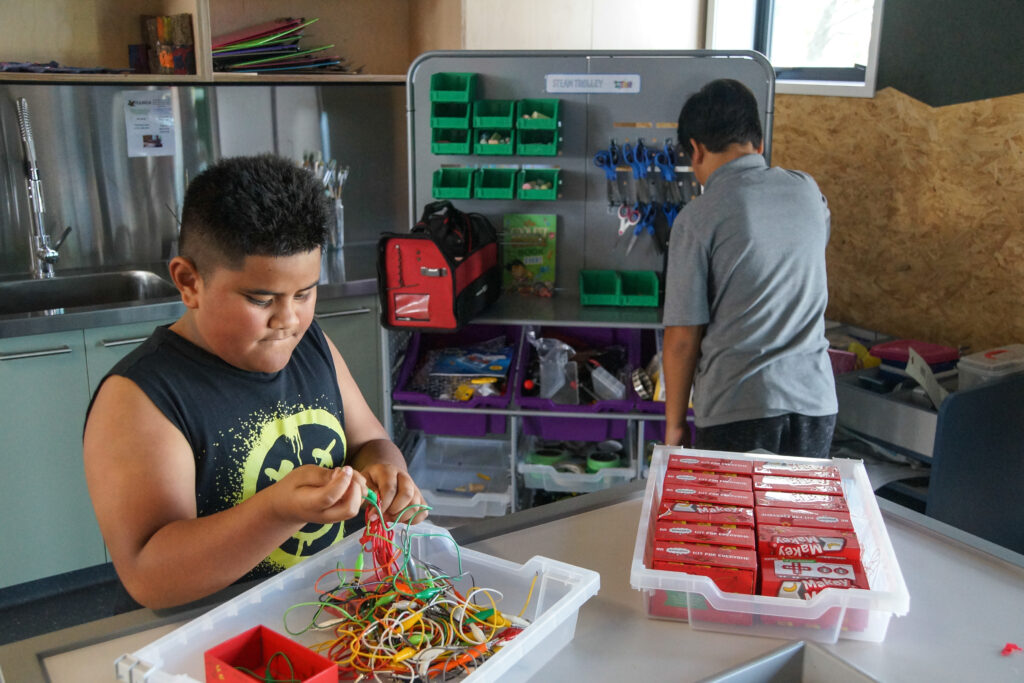
Welcome to Wesley
How one New Zealand school put community, ethos and culture at the heart of their school design.
Wesley Primary School’s (WPS) logo is inspired by its location, ethos and culture. The school in Mount Roskill, a suburban area in Auckland, New Zealand, sits between two maunga (mountains): Owairaka and Puketapapa.
These maunga are represented in the logo as a W, the circular shape represents Te Ao Māori, the language and culture of Māori, and within it are Te Ranginui, the Sky Father, and Papatuanuku, the Land. They are thrust away from each other to show that children have room to grow, and the school motto, Ki te Mārama, which translates as “towards enlightenment”, is displayed.
The lower part of the logo is two connected parts of the maunga; one is a fern, just beginning to stretch out its frond, and the other is a child, sheltered and nurtured by whānau (families). The logo puts into imagery what the school puts into action: as a small school, with just 162 pupils, it’s a place where everyone knows each other, the community focus is strong, and the culture of the whānau is embedded throughout.

Collaborative and supportive leadership
Wesley opened its doors in 1951. Catering for students aged from year 1 to 6, it’s a school that is hugely diverse. There are currently 162 children on the roll, and they comprise of mainly Tongan, Samoan, Cook Island and Māori learners, and smaller numbers of refugees and other children from diverse cultures.
The school is committed to providing a supportive and inclusive learning environment, in which every student is valued and respected. Its leaders feel strongly that any change needs to fit with the vision, ethos and values of the school – and when it comes to new spaces, it’s no different.
Initially the focus of the school design was not lead through a PLSiP framework as there was a hand over period from the previous Principal – Brenda Martin to Lou Reddy who is the current principal of the school. Since 2019, Brenda had worked hard to create an education brief and validated the need for a new school. This incorporated the values and pedagogy of the school which was used by RTA Studio architects to create the first preliminary design for the Ministry of Education (MoE).
Reddy conducted a survey in November 2020 to help better understand the values and ethos of the school. This led him to identify the following areas of focus to help give feedback to designers, staff, community, Ministry of Education (MoE), and his school board –
- What is your role at WPS?
- What do you value most about WPS?
- What are the most important aspects/things/spaces of WPS that we should keep in the new build? e.g. Garden to table spaces
- What are some new aspects/things/spaces that we need in the new build that may not be in the current plans? e.g. Café
It was noted that the feedback highlighted the importance of strong community and learning focused relationships.
In the survey, staff and members of the community identified the supportive ways the school was connected to the families and students from a lower decile background.
The embracing of the local native culture, language and curriculum, shown through the use of community groups, specialist areas and extra-curricular activities, featured heavily in stage one of the design. Wesley Primary School and the local community place great importance on the ‘garden to table’ experience, where specially designed external spaces for growing produce are made available for lunchtime sessions and are used directly within the Food Technology zones within the learning hubs.
The Planning Learning Spaces in Practice (PLSiP) Design Framework was shared with the school, in July 2021. Terry White (PLSiP Co-Director) worked closely with Reddy to share various case studies and examples of contemporary design in MLEs (modern learning environments), that would help him visualise the design of the school’s new learning hubs.
The PLSiP framework was shared with the school, in a scaffolded manner. Reddy worked with White and Doug Crutch (PLSiP NZ Project Co-ordinator) for 6 months with online sessions between 2020 to beginning of 2021 and then this was opened to key leaders and staff in July 2021. Reddy found it helpful to be mentored by White to examine, regarding what a theory of change could look like at the school, through various case studies and examples of contemporary design in Modern Learning Environments (MLEs).
In 2021, Reddy and his SLT team worked with the PLSiP Team to better understand how the school could involve the PLSiP Design Framework to have a shared agreement to communicate with architects, MoE and other designers, in order to meet the needs of their learners. Reddy also identified the need for a learning coach and Samantha Prendergast was a team leader who showed interest and a passion for what Reddy and White had shared.
Reddy had highlighted that by distributing the focus of control to the wider team through Prendergast’s ability to walk alongside staff using the PLSiP tools online, really helped with staff engagement.
During the 2021 Covid lockdowns, Reddy and White shared with senior leadership about the ways in which the PLSiP framework could be useful and unpacked the “Why” for creating a theory of change which was then embedded in their strategic plan for the school.
Reddy reflected on the PLSiP Journey in his September 2021 blog.
As a new principal, I am finding the process really heartening. It’s a great way to understand what the staff, within their teams, are thinking about what learning looks like.
I am also mindful of the challenge to constantly evaluate and reflect on the strategic planning and financial implications of our grand designs.
Principal’s Blog September 2021 – https://wesleyprimaryprincipal.blogspot.com/2021/09/current-and-next-practice-feedback.html
Engaging with the PLSiP Process
The PLSiP approach addresses a fundamental flaw in education systems around the world: many learning spaces simply are not fit for purpose. The framework supports school leaders who want to refurbish existing learning environments or design new spaces that actively support their learning goals.
The first stage was to establish what those goals would look like in practice through a process of review.
To achieve this, Prendergast (Learning Coach) had to co-ordinate this process. Prendergast was the point of contact between the school and the PLSiP team in the UK, collecting thoughts and feedback from school staff, and then feeding back to White and Pandya. This was especially helpful during the Covid 19 lockdowns as the constant communication between everyone, ensured the progress continued through.
Teacher-led transformation
At the classroom level, engaging with the PLSiP Design Framework encouraged teachers to think outside the box, take risks and try new things. It gave them the confidence to know that experimentation is a necessary part of developing innovative teaching practices to support twenty-first century learners.
One of the major benefits of the framework was that it helped teachers to recognise and acknowledge the journey they had been on.
By working through the key themes of; Pedagogy, Curriculum Experience, Organisation of Learning, Leadership of Learning, Community Participation and Research and Data, the staff were developing a holistic and integrated new model for their school design.
All the staff were able to visualise and define their next practice and to build on their existing strengths. They could also identify areas for improvement.
The framework also enabled teachers to develop a systemic approach through exploring everyone’s perspectives and creating buy-in and ownership. This approach was critical in ensuring that teachers were able to work together effectively and to make informed decisions that would benefit their students.
Specific examples include the work of Heidi Rose, the junior team leader, who expanded on her team’s implementation of play-based learning. She also collaborated with deputy principal Shelley Saunders and Harko Brown, a practitioner of toi tākaro, or play-based Māori sports and arts, to develop the school’s māra hūpara, an indigenous Māori playground with natural elements.”

The build: a design with community at its heart
Once the leadership and teaching staff had worked their way through the PLSiP Design Framework and developed an approach to teaching and learning, the work moved on to thinking about what forms of design and build of the new school structures would best facilitate this.
Using the PLSiP Design Framework as a guide, Wesley staff connected with up to 15 different businesses, Ministry of Education staff, the indigenous mana whenua (local people), architects, community organisations, builders and contractors, and brought them all together in one room for a “Design Sprint Day”.
The day was led by assistant principal Andy Crowe, and the schedule was as follows:
Opening and morning session
- The celebration of wēteri kaiako (teachers) and a chance for team leaders to share their design experience and its impact on their teaching practice and students.
Middle session
- Keynote: White spoke about the importance of getting schools involved early and often in the design process.
- Matua Harko: a session which connected everyone through traditional Māori tākaro (play), aimed at helping the group to embrace the challenge.
- Ideation: the teams worked together to unpack and hear about the challenges, then develop solutions.
Afternoon session
- Pitches: the teams pitched their ideas to each other and received feedback.
- Poroporoaki – the farewell: every participant and guest walked away with a native plant and was invited to plant it on the opening day.
Outcomes and impact
- Designing with schools leads to better outcomes for teachers and students.
- Supporting design decisions with evidence, and utilising a co-design framework, enables schools to contribute effectively to the design brief.
The day was an excellent way to establish groups within the community who were keen to support the school, and many were invited to continue their partnership with Wesley school. The insights from the day were then translated into design concepts, which in turn were fed back to the user groups.
A hub building with a clear purpose
The first building opened in 2022, and so far, it has had an immense impact on the entire school community. So, what does the new school building look like, and how does it differ from what was there before?
Perhaps the most notable change is the introduction of collaborative learning spaces in place of single-cell classrooms. Staff recognised that the traditional teaching model, which sees teachers be solely responsible for their own classrooms, was no longer effective for twenty-first century learning. Today, the school operates as a hub model, in which several classrooms are grouped together to form a larger learning community. This encourages collaborative teaching and learning, and provides more opportunities for peer-to-peer support and problem-solving. The hub model allows for greater flexibility and adaptability in the use of space, which is crucial in promoting a more student-centred approach to learning.
In terms of physical space, there have been significant changes to ensure that the school is accessible and flexible for students. Classroom layouts have been reconfigured to include more agile and adaptable furniture, which can be rearranged easily to support different types of learning activities. There was also investment in new storage solutions, which are designed to be flexible rather than fixed, allowing students to take ownership of their learning materials.

To support the new learning spaces, the school has also made changes to the way in which it plans and delivers its curriculum. In the new building, teachers work more collaboratively to plan and deliver lessons, which are tailored to meet the needs of all students, regardless of their abilities or interests.
This approach not only helps to engage students in their learning but also encourages them to take ownership of their learning journey. Specialist spaces were built in from the outset, rather than being an afterthought: there are dedicated spaces on both floors for students to have access to the outside area for outdoor learners, and also dedicated food tech areas, makerspace studios and breakout rooms.
Finally, throughout the transition, staff recognised that some students may require additional support in these new collaborative learning spaces. As a result, they have been working on implementing a range of learning-support services that will allow every student to pursue excellence as defined by themselves and their whānau (families).
Settling into new spaces
Since staff and students have moved into the new learning spaces, they have observed many different positive outcomes and learning gains;
- Collaboration between whole team enhanced through shared teaching and planning.
- Inter-hub grouping of students to better support their mathematical progress.
- All teachers in a hub work with all the students.
- Students move independently throughout the space.
- Students have more choice, not just on the projects they pursue, but also more staff at their disposal.
- Hands on, integrated, contextual and culturally sustaining learning experiences.
- A growing awareness of how learning experiences are resourced and who has access to them.
- Accessible and visible storage for greater student access, e.g. Supporting them to use resources with little to low teacher direction.
- Main meeting area is our fale (house)- where all big ideas in the hub get discussed.
- Students having an opportunity to lead their learning through their passions and interests.
Defining the next steps
Now that staff and pupils are working in the new build, they have identified further ways to enhance stage 2 of the design. This includes how staff can support students with learning needs that span an increasingly wide spectrum, how they can improve the attention span of the students among a hive of activities, and how they can organise learning within the space.
As the school moves into this next stage and considers how to implement the next areas for development, it will be supported by the PLSiP team, architects and project managers.
“Our Kura (school) has embraced the PLSiP Design Framework in order to prepare for the transition into our new build. The process has allowed for my staff to authentically share their ideas and to identify areas for improvement in the new building. Throughout this collaborative approach we have ensured that the culture and values of our local community have been at the heart of our design thinking. I would strongly encourage any school undertaking a new build to review and participate in the PLSiP process”.
Lou Reddy, school principal
